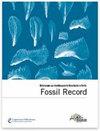托尔西亚蛭石战场的炮台大小差异
IF 2.1
4区 地球科学
Q1 PALEONTOLOGY
引用次数: 9
摘要
摘要据报道,在危机期间,身体大小发生了变化。Belemnites——现在被认为是已经灭绝的十臂干动物——很少有人为此目的进行研究,而且为数不多的研究导致了模棱两可的结果。在这里,我们在计算机断层扫描数据的支持下,从形态计量学的角度研究了德国南部的两个托阿尔期贝仑岩堆积。这项研究的目的是测试是否可以在两个研究样本的喙之间观察到大小的差异,从个体谱系到群落,以及哪个代理更可靠。从早期蟾蜍期(Dactylioceras tenuicostatum区)到中期蟾蜍期(Haugia variabilis区),中值尺寸显著减小。这是在组织的群落水平上观察到的,考虑到整个组合,但也在属水平上的Passaloteuthis–Acrocoelites谱系中观察到。研究还表明,基于直径的测量或最大保留长度不是尺寸的可靠指标,因此更可取的是根尖长度或三维近似值,如几何平均值或膈腔后体积。当比较主席台形状明显不同的标本时,这一点尤为重要。然而,仍有必要进行进一步的研究,以理清蟾蜍讲坛规模缩小背后的机制及其假定的环境原因。本文章由计算机程序翻译,如有差异,请以英文原文为准。
Rostrum size differences between Toarcian belemnite battlefields
Abstract. Body size changes have been reported across crisis intervals. Belemnites – now considered extinct stem-decabrachians – have rarely been investigated for this purpose, and the few studies have resulted in ambiguous outcomes. Here we investigate two Toarcian belemnite accumulations in southern Germany from a morphometric point of view with the support of computed tomography data. The aim of this study is to test whether a difference in size can be observed between the rostra of the two studied samples, from individual lineage to community, and which proxy is more reliable. A significant decrease in median size from the Early Toarcian (Dactylioceras tenuicostatum Zone) to the Middle Toarcian (Haugia variabilis Zone) is recognized. This is observed at the community level of organization, considering the whole assemblage, but also within Passaloteuthis–Acrocoelites lineage, at the genus level. It is also demonstrated that diameter-based measurements or maximum preserved length are not reliable proxies for size, and therefore apical length or three-dimensional approximations, such as the geometric mean or the post-phragmocone volume, are more advisable. This is especially important when comparing specimens with markedly different rostrum shapes. Further studies are, however, still necessary to disentangle the mechanisms behind the reduction in rostrum size within the Toarcian and their putative environmental causes.
求助全文
通过发布文献求助,成功后即可免费获取论文全文。
去求助
来源期刊

Fossil Record
PALEONTOLOGY-
CiteScore
3.60
自引率
7.10%
发文量
18
审稿时长
14 weeks
期刊介绍:
Fossil Record (FR) is the palaeontological journal of the Museum für Naturkunde Berlin. This journal was founded in 1998 under the name Mitteilungen aus dem Museum für Naturkunde Berlin, Geowissenschaftliche Reihe and appears with two issues each year. Fossil Record publishes original papers in all areas of palaeontology including the taxonomy and systematics of fossil organisms, biostratigraphy, palaeoecology, and evolution. All taxonomic groups are treated, including invertebrates, microfossils, plants, and vertebrates.
 求助内容:
求助内容: 应助结果提醒方式:
应助结果提醒方式:


